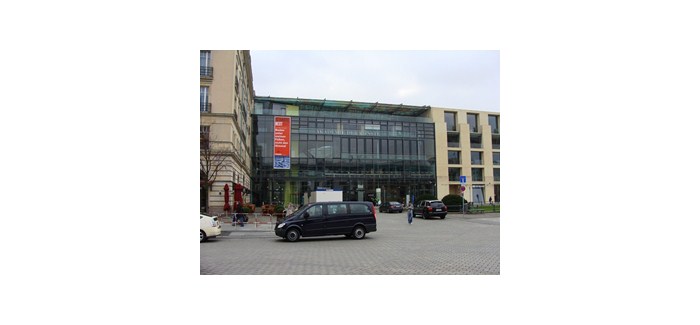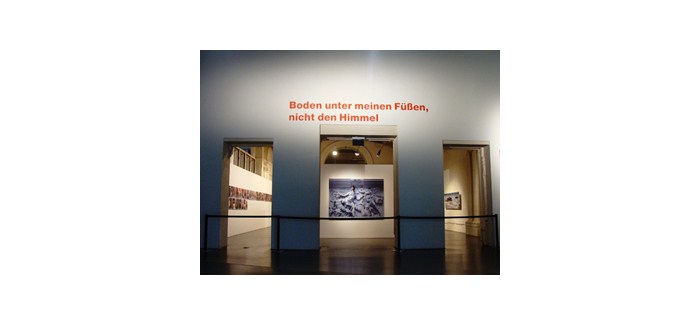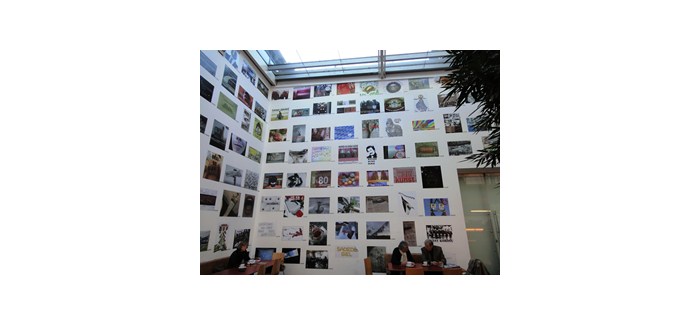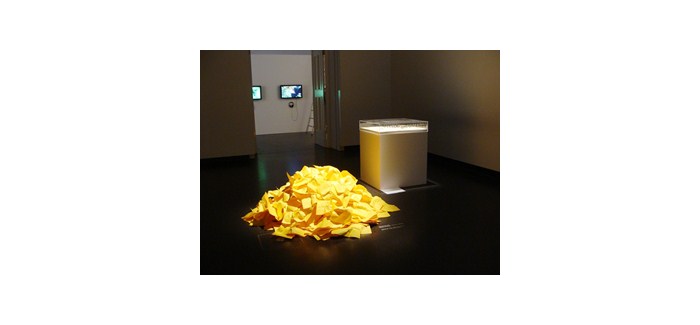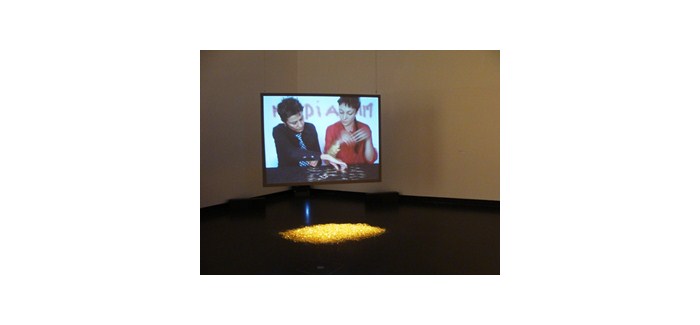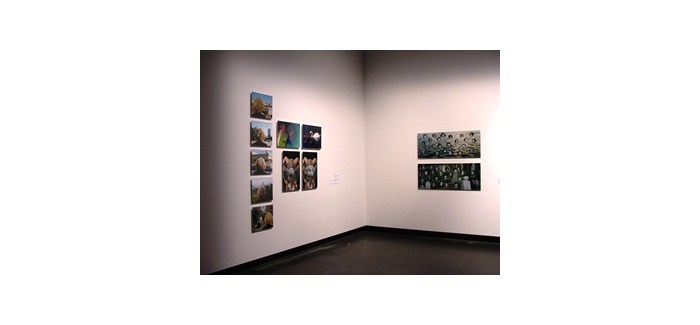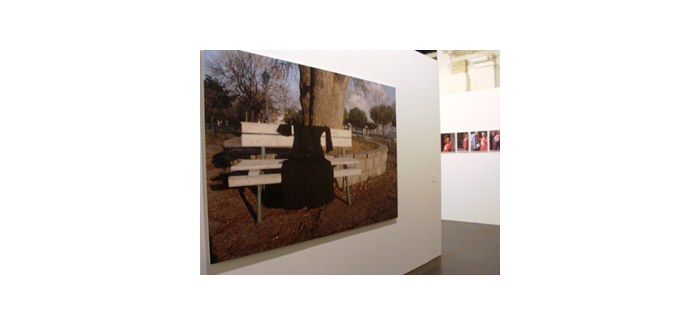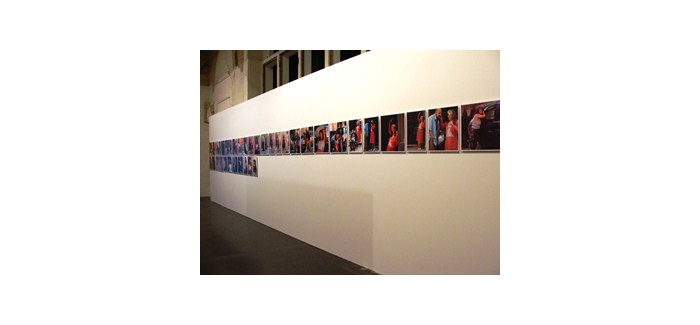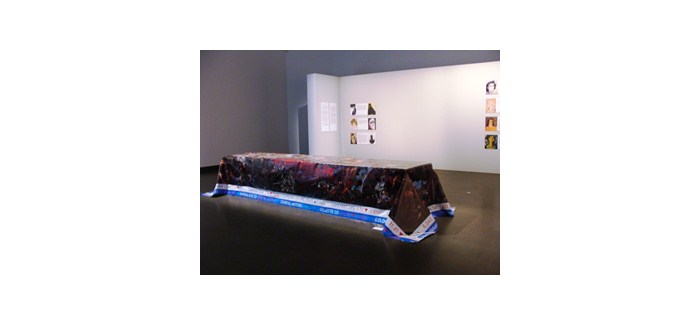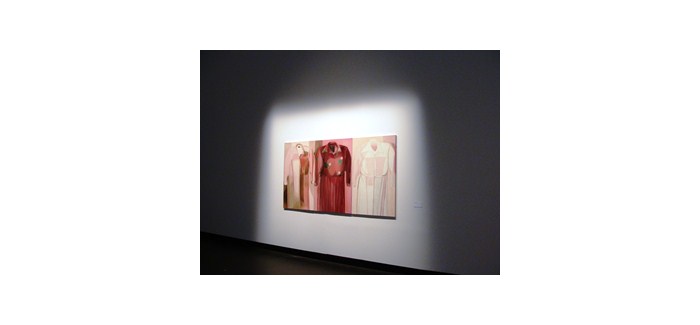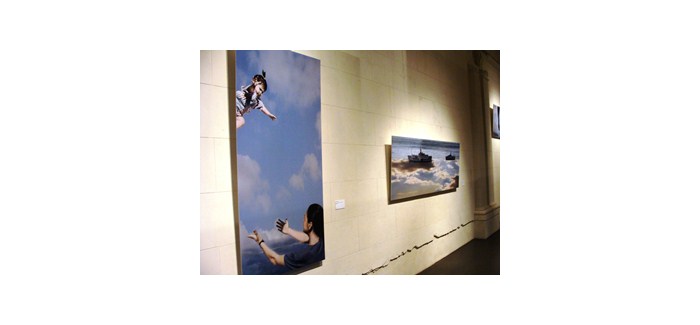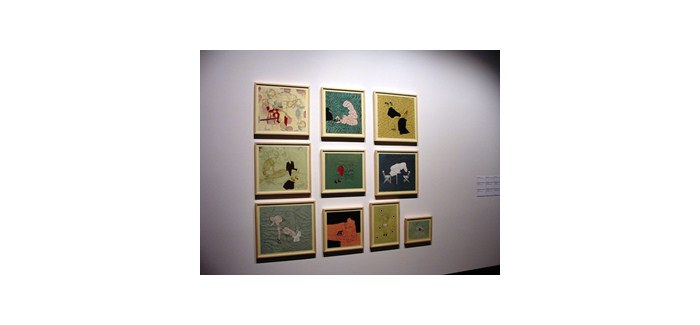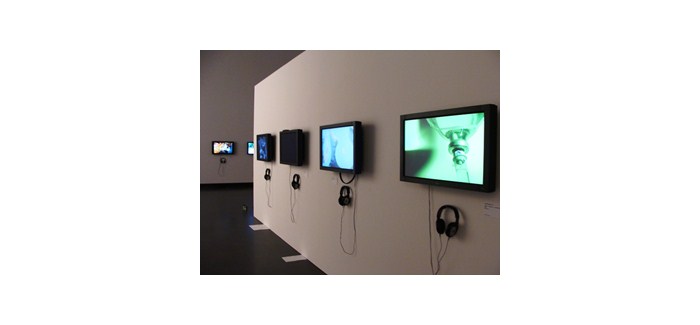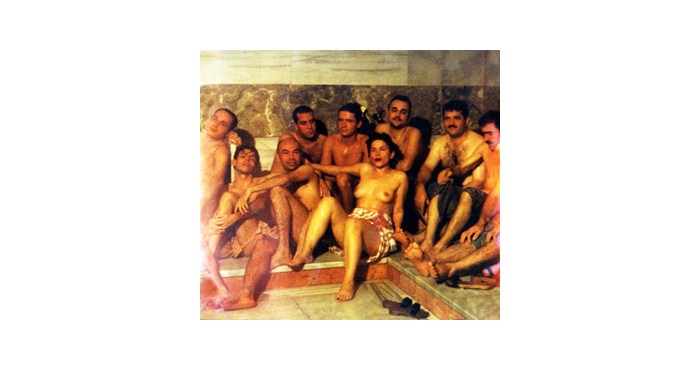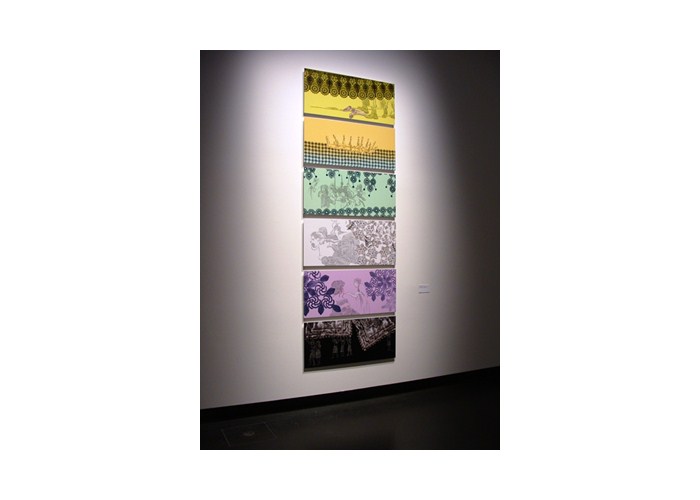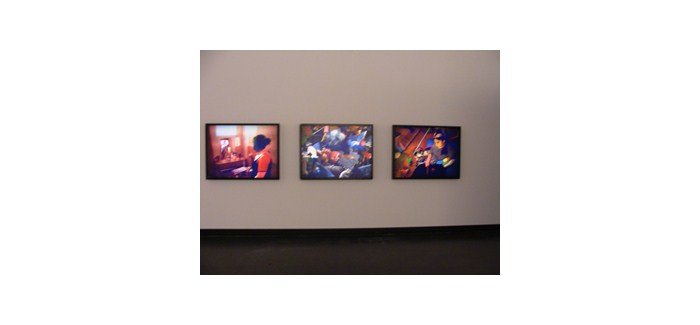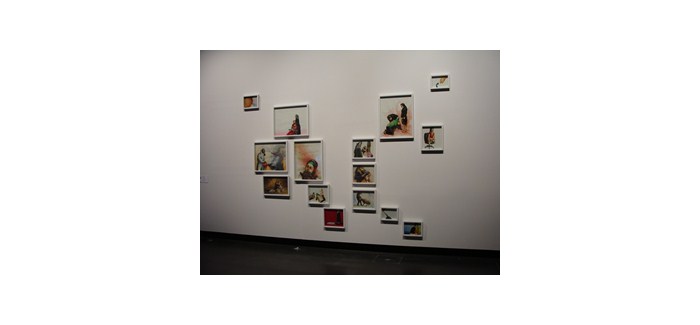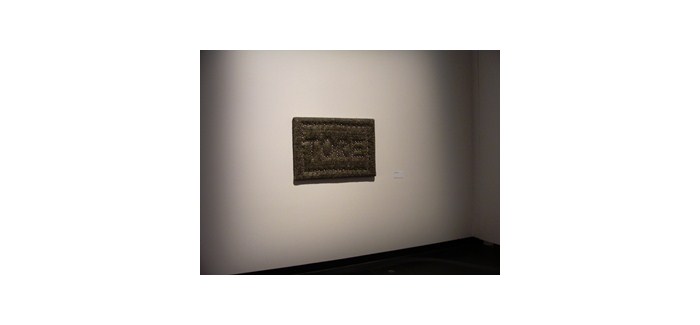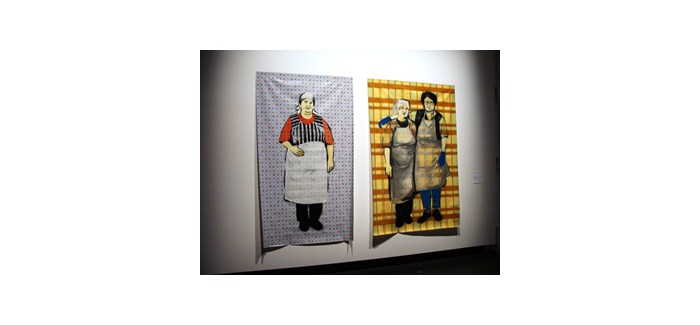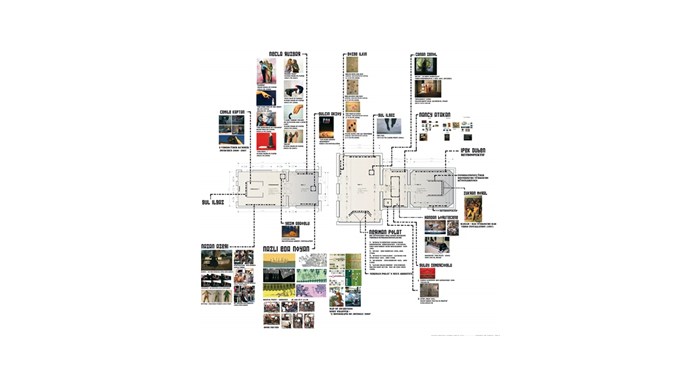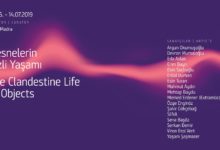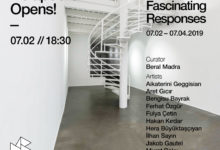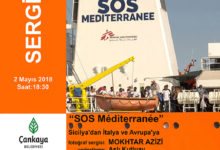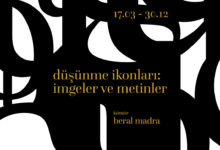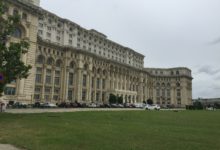B.M._Under My Feet I Want The World, Not Heaven
“Under my feet I want the world, not heaven!”*
“Under my feet I want the world, not heaven!”is my third major exhibition in the last decade that has an exclusive focus on the works of women artists (1).
Given that Turkey, with its troubled but nearly a century-long process of modernization and democratization, is a somewhat unique country within the Muslim world, and given that its modernization has been consistently analyzed through the status of women within its predominantly Muslim and culturally conservative population, this focus should not come as a surprise. Contemporary art practices of women artists within this homogenized cultural field have gained an emblematic status. As the international art discourse began to focus on non-European contexts with growing interest since the early 1990s, Turkey achieved its presence and position on this competitive platform, in part, due to the highly dissident and transgressive works and practices of women artists.
Considering the attention and interest of the public to striking headings and fulfilling the expectations of conceited audiences I entitled the exhibition “Under my feet I want the world, not heaven!”. The title of the show is a slogan fromthe protests of 3000 women in Istanbul on 17 May 1987—an event which is discussed by Zuhal Yeşilyurt Gündüz’s in her essay on the Women’s Movement in Turkey (2). The slogan is a creative intervention into well-known religious dictum which glorifies women qua mothers: “Heaven is under the feet of mothers.” With the religious nomination in the slogan, the sacrosanct position of the mother is ingeniously cut off from the worldly notorious women. At that crucial date, using this as their catchphrase, those 3000 women have designated a new turn in the position of women.
The title is challenging in the sense that it accentuates the revolt against being designated to represent the sacrosanct image of motherhood and not to exist otherwise. With the title I wanted to draw some attention to the continuing exploitation of the image of woman under the neo-liberal, global capitalism and prevailing religious, traditional and conservative dogmas, but the artists’ statements effectively reflected in their works do more than that…
Furthermore my approach to this task of making an exhibition with women artists involved some concerns and convictions.
Who and what can compete with the commodity and media culture and gain ground? The identity of women in Turkey is thoroughly connected to politics, religion, consumption culture and media. Since two decades the female identity is sharply divided firstly into “headscarf” and “no-headscarf”, secondly into “protected” and “not-protected”, thirdly “conformist” and “non-conformist”. These divisions once again show the prevailing patriarchal and dogmatic social structure. The female body experience is mostly connected to sexual abuse and violation of young or elderly women or to a body culture based on cosmetic industry. These issues are mainly tackled by women artists of this exhibition with their socio-political-cultural origins and effects and appear in their works as self-portraits, performances, documentations of their performances or as representations and metaphors of an actual practice, experience or a profound research.
Now, some notes on the background of this exhibition…
Turkey, despite its unique and early introduction into modernism, and despite its image as an emerging democracy with an ambitions to become a EU member, remains a part of a vast geography from South Caucasus to Middle East, from East Mediterranean to South Asia, where the majority of women, with their soul and body, are essentially considered to belong to the family, tribe, clan or conservative society. In Turkey this majority has a class implication as well. It consists of classes living in rural Anatolia, in the margins of the cities and in the blighted areas within the centers of the cities. We see these women in two poles, labeled either as successful, emancipated career women or as distressed, hopeless middle and working class women. In reality both sides inhabit the same climate that makes the woman-scape in Turkey cloudy and stormy: under the ever-present patriarchal system and a deep traditional male hegemony which is overtly or implicitly reflected into the constitution, law and state policies.
Feminism in Turkey has recently been discussed extensively in a dialogue between two well known scholars Ayse Düzkan and Meltem Ahıska. (3)They acknowledge that feminism is mostly discussed under the term “women’s issues” and began as a state-led modernization policy during the early days of the Republic and that a contemporary feminist movement was able to emerge only after the weakening of the socialist movement in the 1980s. However, the Republican state policy remained to be a haunting ghost: “Why would there be a need for feminist movement,” pundits asked, “when the state has already bestowed the women with their rights?” But perhaps equally importantly, the movement was never a unifying one. It was marked by a division, according to which the upper class business women had their priorities and the middle and working class women had to struggle through the paths of tradition, religious dictums, and economic hardship and injustice. Düzkan and Ahıska indicate that even in the 1990’s the women issues continued to remain under the siege of the socialists, the Kemalists, the Muslims, the liberals or capitalism. They acknowledge that both the already existing patriarchal order and the newly emergent neo-liberalism continued to appropriate the identity of woman as a tool of buttress of their power.
The scene has not much changed since that conversation. However, since the late 1990s, the press and other media became more vigilant about reporting the stories of women who are raped, violated, murdered, or forced to suicide. While this makes the public more conscious of the state of women in this patriarchal-neoliberal order, it also makes it more guilt stricken and horrified. Yet, feminism is still defined either as subversive or old-fashioned, even if most women-rights associations deploy the feminist discourse in a highly subdued manner. Even the women artists who deal with feminist concerns avoid being defined as feminists. In its current state, feminism as a theory or practice is limited to a number of academics and activists and the heterogeneity of feminism remains to be acknowledged. The public opinion does not seem to budge even as the cases of women violations and honor crimes continue to grow at a dramatic rate.
There are dissident women in every field, yet there is also a significant difference between the attitudes of those who practice feminism within the academic and political fields and those who practice in the field of art: the latter group seems to me to be more fearless than the former. Woman artists are sometimes more daring in their attack to the status quo, in opening the box of Pandora, packed full of profound problems. Yet, most academics and NGO activists do not view the practice of these fearless woman artists as a constructive endeavor in challenging the public opinion. The women artists however, have already been acting as dissident guide posts with their art making as early as the late 1970s and throughout the 1980s, not to mention their successful passage to the international scene in the 1990s with their provocative works. Here, I must point out that during my career in the 1980s, first as a female gallery owner and then later as a curator, I was not recognized by the academic and political feminists in Turkey as a part of the feminist discourse up until the moment when I curated a show with woman artists on March 8, 1995 in reference to Judy Chicago’s Dinner Party, inviting 20 artists to make a work on a white porcelain plate.
Given the general argument of the artists’ works, “Under my feet I want the world, not heaven!” aims to subvert the current refusal of being identified as “women artist” with the argument that it brings another discriminative tool into the debate, to the advantage of an exhibition with women artists. The socio-political and cultural background I tried to describe here gives me many reasons to strategically accentuate the position of women artists in Turkey.
In the exhibition the viewer is invited to discover this venture and quest of women artist by walking from the present to the past. Here, I make my comments chronologically.
Beginning of 20th Century: Emergence with Dilemma
The Westernization program of the Ottoman Empire and the foundation of the Academy of Fine Arts (Sanayi-i Nefise, 1881) opened the way to the upper class families to allow their daughters to be educated in art. These painters were not directly involved in politics, or in social commitments, but should be mentioned as creative pioneers in the long history of women emancipation in Turkey. However, in the self-portraits of Müfide Kadri, Mİhri Müşfik, Hale Asaf with and without veil, which we show in this exhibition with reproductions, we can observe the dilemma of having identity problems. They mirrored their veiled and unveiled identity in their own images.
I wanted to give a historical perspective to the practices of women artists; consequently I first focused on a self-portrait series of early women painters with the intention to reveal the identity problem of women during the last decades of Ottoman Empire. In this series one can recognize the split-identity of these women, who dared to be artists. Most of them are members of so called Westernized upper class families, well educated and cherished as talented daughters, sisters, and spouses. However, making a self-portrait is still a daring act, and in particular, I think that whether the self-portrait is with or without veil is a symptom of their identity search.
At that period the male painters have depicted even naked women figures; however these paintings rarely reveal a conscious fetishization of the female body. I don’t think that at that period we can specify a voyeurism of the male gaze, when we discuss about the male dominance in painting practice. The women figure in the paintings served again as an element of self-confidence and bravery during the Westernization process.
Nazan Azeri’s text “Women Painters in the Process of Westernisation”, in this catalogue will give the reader detailed information about these beginnings.
1930-1970: In quest of Consciousness
The Modernisation program of Atatürk bestowed the women with extraordinary rights when compared to the status of women in Western European countries during the three quarters of 20th century. However, the constitutional rights did not always correspond to the traditional position and status of women; thus expelling the rights of the lower class women and leaving the so called avant-garde women alone and vulnerable in their quest of consciousness of their status. Here again, the upper class women could maintain their profession as painters with the support of their families and elite communities. Looking to the self-portraits of these women, we can see in the way they depict themselves that their judgment on identity is split between conformism and modernism. Throughout these decades, up until 1950’s women artists profile did not change. Painting has always been a seductive way of contributing to the transformation of the society and acquiring the features of bourgeois life-style. The women were essential figures of the transformation and they successfully played their role in it. Looking to these self-portraits one can see their assumption of their image being transferred from ideal ego to a more social one!
Their professional attempt might be also named as rupture from tradition and finds it examples in the 1950s and 1960s, when Turkey turned its face to USA, based on the political connections that transformed the general political climate into Cold War. As late modernism this period is exemplified by the male artists behaving as rebellious and capricious individuals, by the women artists- even if they are still from the upper class families –behaving more independently than before. At the same time the emergence of leftist ideologies opened the way to women entering in the political arena, however it is not reflected into the paintings. The art scene started to liberate itself from the official modernist program and found its own orientations either to communism or to capitalism only after 1970s. During 1950s and 1960s the women artists ventured in to the individualist, independent and emancipated art making, but did not surmount the by now the conventional language of expressionist style and standard themes, such as landscapes, interiors, portraits and self-portraits . Among many others Furumet Tektaş, Leyla Gamsız, Şükriye Dikmen and Fahr el Nissa Zeid (1901-1991) and Aliye Berger are discerned with their maverick painting style, innovative compositions and feminine spirit.
In the strict patriarchal circumstances and male dominated art scene their attitude was enterprising for the next generation. If the Modernism of 20th century peripheral art scenes were registered in its time, Zeid would be mentioned as an early abstract expressionist, in comparison to Jackson Pollock and his circle. She set on the possibilities of merging the modernist canon with the spiritual intricacy of Islamic motives.
Among the next generation of artists Nil Yalter, who lives in Paris since 1965 and Füsun Onur are the pioneers of non-conformist art making and introduced practices of time-space-culture related art works. While Yalter addressed ethnic problems, cultural identity and women’s issues, migration utilizing photography, documents, computer-video, Onur, as an early Fluxus artist, focused on everyday aesthetics and materials, to transform them into narrative, ephemeral and poetic installations.
1980s: Breakthrough into Individuality
Woman artists in Turkey have been producing assertive, attractive and probing works since the mid 1980s, and currently they are receiving the international attention. One cannot deny the prevailing male dominant discourse within the modern and postmodern art making; but women struggle to get their economic and social identities along with their democratic rights and post-modern liberalism in the mentality of the society, which help them to become more independent. Post-modernity in Turkey was a step forward for them, but it was still not an easy task to change the status quo. In tune with the human rights and feminist movements, the women artists have deconstructed the meta-narratives and the traditional positioning of the outcast or oppressed women of all classes through art discourse and subversive art works. The women artists were aware that to be able to do this, the modernist mentality that structure of the society and its institutions has to be radically changed. Within this context, the probing, questioning, and shocking examples of contemporary art works carry an important mission and among them, the sharing, communicative, flexible and contributing qualities of woman artists’ works produce favorable results, even as these works remain largely unrecognized as political tools for radical democratization process by the women’s rights NGOs and feminist academics and activists.
Modernist art production was considered to be elitist and have failed to address the political adequately. Post-modern art practices are also perceived to be too sophisticated, too high-brow by the majority as well as by the bureaucrats and the business sector as the supposed supporters or funders of art. To be entirely honest, this is not necessarily a gender issue. Politically charged art-works by male artists are also being devalued and ignored as a legitimate platform for political protest or activism; contemporary art practices, in general, are not included into the culture politics of the political and economic actors.
Even though we cannot speak about a concrete and calculated women’s art movement in Turkey, we can distinguish a definite visibility of women artists since the beginning of 1980s. And this emergence had the varied form of women coming together and exhibiting their work in solidarity or being invited to artists’ associations and exhibitions organized my male artists. It is difficult to define a feminist avant-garde art during the early and late modernism, and until the late 1980s feminism or a kind of female identity in art was not politically and culturally manifested in art-works. The women artists no doubt suffered from living and practicing within a patriarchal context, from being excluded from decision-making positions, from being discouraged in realizing their projects and ideas. Art was not the field for feminist debate and, even today, is yet to become one. Yet, since three decades the visual agenda is opulently occupied by women artists. Most of them have gained their firm position through their increasing attachment to the international art world. At present, even though the middle and working class women in Turkey remains to be marginalized and exposed to male dominance, and even though, feminism in art appears to be passé, their works reflect all the problems of women population in Turkey and manages to stir debates. Generally the middle upper class intellectual women–women artists (and curators) are mostly coming from this class–have learned to act strategically and to play according to the rules of the game.
The art production of 1980’s evolved into two directions: Painting with strong influence carried on local figurative and abstract tradition from 1960s and 1970s. The practice of conceptual art and installations emerged gradually with a more intricate socio-political and cultural content. In painting, expressionism lived its new birth with a bold figurative style, with subjective criteria and personal mythologies. Throughout 1980s a generation clash, a questioning of Western art, a rupture from the recent past, a yearning to the historical past and an affiliation to the international contemporary art making can be observed. The new approach to dilemmas such as tradition and modernism, high and low art, rational and irrational was to find points and fields of reconciliation between these dichotomies and in most cases the low, popular and trivial became more visible. Austerity and ascetic behavior was avoided for the sake of openness to different directions and possibilities.
The new task of recognizing and taking hold of an emerging global and decentralized knowledge and network tempted the artists to create independent group movements in order to cope up with the stagnated conditions of the official cultural policies. The utilization of new media and materials, the impact of every day iconography, the tendency towards populism and triviality were the signs of a new complacency between high culture and the mass culture which is the most significant rupture from Late Modernism. The artistic language gained new techniques by making use of materials borrowed from everyday life, such as construction materials, electrical devices, furniture and traditional arts and crafts examples.
The real rupture from the unfinished and restless Modernism happened in 1980s; even then with some reluctance. New expressionism in painting, the existentialism in philosophy, last representations in novel writing, stars in films were the last extraordinary forms of Modernism; it consumed itself within these forms. The question whether the viewer has really experienced a radical rupture from the restrictive and imperative Modernism is still to be answered. The Modernism prevails in the official culture and the distance between the liberated art scene and the intentions of the state and conformist governments grew to an extreme alienation. Artists such as Neşe Erdok, İpek Aksüğür Duben, Nur Koçak, Gülsün Karamustafa, Canan Beykal, Ayse Erkmen, Hale Arpacioglu, Inci Eviner, Handan Börüteçene, have reflected this rupture in their paintings and installations from early 70’s and 80’s on.
1990s and the New Millennium: Challenging the Patriarchal Order, Provoking Visual Thinking, Building Relational Aesthetics
The culture climate of the 1990s was deeply affected by the political and economical transformations. The economic transformation can be summarized as the intensive communication and interaction of the private sector with the world business, increase of export, foreign partnerships, specialization of the businesses and finally integration to the global economy. The transformation created its new social classes, among them the new middle and rich class that entitled to gain the character of bourgeoisie, but was also faithful to its ethnic and rural traditions. People from Anatolia have immigrated to the margins of the city, and to the abandoned parts of Beyoğlu district which belonged to the Greek, Armenian and Jewish minorities in the past. In particular, this at that time low rent district generated a new synergy when the artists, also preferred to live and work there, side by side with the newcomers.
From the cultural point of view the 1990s have opened a new possibility of being liberated from the burdens of a constrained Modernism, or celebrating the fall of Modernism. In this sense a new split has been experienced among the intellectuals, namely the ones who could not accept the fall of Modernism and faded away from the most up-to-date culture scene. In the meantime the diversification of creativity, the interest of the private sector in contemporary art and design works, the emergence of markets for creative products and the international exchange options have enforced the content and impact of the culture industry.
In the 1990s the winds of globalization reached Turkey and the rapid transformation from modernist isolation to global inclusion started in intense cultural exchange with the art scenes in EU countries, particularly those with the majority of Turkish emigrants. With the zenith of corporate art and culture centers, with the total privatization of the art scene and with the emergence and domination of the local and international curators the artist’s position changed from fosterer to perpetrator or implementer.
Without doubt the relations with EU within the framework of its enlargement and cultural integration policies have definitely changed the course of art and culture in Istanbul. The process started in the 1990s on strictly individual networking level and gradually developed into an institutional relationship, mainly between private museums, fine arts faculties, artists associations and other NGO’s. The projects and exchange activities were mostly funded by EU resources. This interaction was by and large possible in accordance with the influence of culture industry in the processes of global economy and politics so that the culture in Turkey gained independency, autonomy and the interest of the private sector. Precisely this progression prepared the rupture between the Istanbul based contemporary art productions and Ankara based cultural policy. While the state monopoly on the arts as the cultural manifestation of the modern nation state ideology is still prevailing in Anatolian cities, despite the current privatization movements, Istanbul art scene has gained precedence in the global art map.
Globalism introduced new possibilities of emancipation and became an ally for female artists. Even if it has never been too easy to change the status quo, this time the international exchange empowered the position of women artists. For opening up the field of the social for the hitherto excluded subjects–among them is women of all classes and professions–dominant meta-narratives have to be challenged. The modernist gaze of the audiences needed to be transformed and the institutional concepts needed to be reconfigured. Without doubt, such a vision of a pluralist society is yet to be realized. However, the so-called traditional female qualities of sharing, communication, and flexibility and the desire to collaborate are becoming more and more important and I believe that they have a great deal to offer in contribute to the fundamental changes that are already beginning to take place in our region.
In the 1990s there were many success stories of women artists such as Sükran Aziz, Sükran Moral, Hale Tenger, Canan Tolon, with site specific installations, transformation of sociological material, performances, video and photography… Towards the end of the 1990s, women artists have produced works with intensified content of socio-political criticism, among them, Selda Asal , Selma Gürbüz, Gül Ilgaz, Aydan Mürtezaoğlu, Neriman Polat, Gonca Sezer, Canan Senol, Sermin Sherif, Zekiye Sarıkartal have challenged and questioned the patriarchal family structure, sexual repressions, child and women abuse, media influence on women and consumption of women as a fetish-object in the affluent society. The current art scene is crowded with women artists with more ambitious goals of creating perceptive, experimental, participatory models of art making. To name among others Nevin Aladağ, Yeşim Ağaoğlu, Nazan Azeri, Nancy Atakan, Gülçin Aksoy, Özgül Arslan, Deniz Aygün, Gülsen Bal, Özge Baykan, Bengisu Bayrak, Banu Birecikliğil, Banu Cennetoğlu, Fulya Çetin, Nezaket Ekici, Silvia Erdem, Esra Ersen, İnci Furni, Leyla Gediz, Zeren Göktan, Deniz Gül, Nilbar Güreş, Gözde İlkin, Cemile Kaptan, Bengü Karaduman, Yasemin Özcan Kaya, Nazlı Eda Noyan, Ceren Oykut, Günnur Özsoy, Necla Rüzgar, Gülay Semercioğlu, Nihan Sesalan, Ani Setyan, Mürüvvet Türkyılmaz, Nalan Yırtmaç, Dilek Winchester are either nomads, living in different contexts according to what the present offers to them, or prefer Istanbul for their attention and practice.
The exhibition introduces seventeen artists of three decades and three generations who have the common aspect of being active individuals, provocateurs, activist-artists in a country which is simultaneously democratic, global, patriarchal, neo-liberal and nationalist. They and many others who are not represented in this exhibition helped us to recognize the importance of the use of verbal and visual language in our daily lives as well as in the democracy process and strived to make art that decipher the ideologies created by images and texts of neo-liberalism, which shape our culture and life. They manifestly provided new visual material and tools of thinking and criticizing the political and neo-liberalist intricacies.
Since early 1980s IPEK DUBEN‘s works reflected her strong social and political involvement. The Sherife series (1982), showing a standard dress painted in Pop Art aesthetics was an indirect manifestation on the stereotype image of majority of Turkish women, namely being a modest mother, a submissive housewife or a weary worker. This work did not only determine her orientation in the art scene as a dissident artist, but also an early example of feminist art. Later, in Manuscript 1994 she had a political message about the status and rights of women in Islam. In Artemis, (1995) and in LoveYouForever (2001) she persistently worked on women issues and used Turkish and international data and on honor crimes and family violence victims. Duben has also tackled the East-West dichotomy in 1990s art making in Turkey and produced a series entitled Register and Traces (1990-91), in which she used Islamic patterns and simple repetitive figures – evidently self-portraits- floating into each other but never fusing on the surface of the painting. Thus she introduced a new deconstructive way of dealing with century’s old East-West dilemma of the painter. Her family life between Turkey and USA has influenced her work in the way that she made videos and artists books on identity and emigration, such as What is a Turk (2003), FarewellMyHomeland(2005) and Crossing (2007).
Although ŞÜKRAN MORAL is mainly living and working in Rome since 1989, she is not a typical “Diaspora” artist, because of her continuous interest in the socio-political developments of her home country; in fact she has produced and exhibited most of her radical works in Istanbul. We should consider her work as a continuation of the post-war tradition of performance and feminist art as manifested in the works of Judy Chicago, Carolee Schneemann, Ana Mendiata or within the context of feminist strategies of 1980s. Gender discrimination, women rights and freedom and corresponding conflicts in Christianity and Islam was articulated and interpreted in her performances Speculum & Obituary ( 1996 -1997) ,Istanbul in Istanbul (5th Istanbul Biennale, 1997 ) and Hammam (5th Istanbul Biennale, 1997). All these works are products of long and daring performances and semi-documentary and straightforward in their message, but metaphoric and aesthetic in their structure. In Istanbul in Istanbul she realized the impossible and acted as a prostitute in the famous compound for legal prostitution in the Kuledibi district of Istanbul. Although legally accepted, prostitutes are one of the most marginalized human groups in Turkey. Moral has not preferred the easy way of approaching this group of women by making interviews with them, but acted as one of them and documented her 24 hours performance.
Since the beginning of her career, HANDAN BÖRÜTEÇENE has produced interrelated works, which referred to history, tradition and memory. Her’s is a continuous journey through the paths and labyrinths of the past, to return consecutively to the present and implicate on the repetitions and of history, art history and tradition. With her extensive knowledge in archaeology and art-history she keeps on linking the current political events, social traumas and global dilemmas with the objects and the images of the historical and art-historical heritage. She makes art by setting different ways of expressions free, by executing different labors. The synthetic canvas sheath, made to cover a long table in Hotel des Bains, the prominent art deco Hotel in Lido, was realized for Open 2002 in Venice. Entitled Reserved for Peace (motus animi continuus), it is also the first part of a trilogy, which was realized later in Borusan Art Center and French Cultural Institute in Istanbul.The totality of this trilogy incorporates a vast knowledge like a hyper-text and evokes a deep insight into grief, anguish, pain, remorse, distress, misery, sadness and dread caused by wars. Börüteçene juxtaposed the Victory at Lepanto (1571) painting of Andrea Vincentino with the current global war-scenes, which have increasingly catastrophic effect on human existence. The painting was printed on synthetic canvas and the original photographs of the current wars were assembled and stitched with gold threat in between the images of the painting. The sheath was framed with the symbol of the global economy, which is the blue and white stock exchange band as seen on the most influential global TV networks.
In NANCY ATAKAN’s work ensemble we can distinguish her quest for positioning herself into the Turkish society and testing herself as being an outsider. By asking unrestricted questions to people and to herself through photography, digital photography and performances she tackles socio-political issues and problems which are both personal and communal. Being married to a Turkish man means to cross the threshold of the patriarchal family sphere. It is a sphere of influence, where the position of the woman is ambiguous. Even if her family domain is not a conventional one, she has the possibility to look into the dubious traditionalist-modernist family structure in Turkey and convey her observations and interpretations. From this point of view, the videos such as Faltaşı (1999), Taxi Driver’s News (2001), My Wall (2004), And (2007), Prediction (2007), I Believe/ I don’t Believe (2009), Used To be New (2009) are based on research, interview and observation on often simple everyday subject matter, but with a unique way of making sense that touches the core of the social and cultural problems. She is not interested in her position as an immigrant, but in whatever makes this culture.
Although internationally renowned, NERIMAN POLAT has the ability to preserve her nonchalant position in the Istanbul art scene. Since 1996, she mostly participated in group shows realized in non- profit galleries and public spaces and instigated by the artists themselves (such as Hafriyat Group). Polat’s work aims to get in touch with the potential of the viewer to see things beyond consumerism and media image. The photography series which show similarity, collectivity or correlations in the urban environment, architecture and decoration conspicuously reveal the spirit, attitude and state of mind of the people. In these images resemblance and similitude becomes a tool for her to circumvent the desire of the viewer for pseudo- originality and find a safe ground for critical thinking. Indicating the peculiarities of resemblances in different layers of culture and examining the stereotype behavior of unsuspecting individuals and their environment she performs her political commitment. In her videos which ingeniously seize a tragic or fatal story out of the daily life, out of a simple event or act in the streets of Istanbul, she exposes the psychological map of the society, as realized in Two Partridges (2005) and Bad tempered Sweet Woman (2007). We can also distinguish in her work a certain complex act of putting herself into the role of the marked subject, to look for and to find out the invisible story behind the visible. I will Blow my Head and Go Away (2006) and On Cutting 1,2,3 (2009) are two examples of this impersonations.
Throughout the years GÜL ILGAZ has questioned her own awareness and attitude within the conservative family structure and within the complexity of gender problems in Turkey, through her works. In the last decade her art making shows two directions. One is autobiographical, scrutinizing her relation, devotion and dependence to her family through family photographs, as in The Hug (2008). She accentuates her position within these images as an emancipated woman, as a mother and a wife. The other production, such as To Fall (2004 is based on performance documentations or genre photographs in which she poses as one of the performer or landscapes into which she inserts herself. For this exhibition Ilgaz produced a digital photograph Athena (2009), inserting her head, hands and feet to the Athena figure of the Pergamon Altar. Ilgaz both identified her power as an artist with the mythological power of Athena and got hold of the warrior identity of Athena by entering into her body. As an art historical image, the Athena figure is being exploited for the desire of the artist, to feel the mythological power of a goddess. From the perspective of historical architecture, Pergamon Altar is one of the most successful monuments of Hellenism, the earliest fusion of East and West. From the perspective of history, it is one of the most controversial archaeological items that symbolize the compromise of the Ottoman Empire to European Imperialism. Ilgaz graciously inverts this memory to today’s relation of Turkey within the EU integration process and illustrates the ambiguity of the relationship.
CEMİL E KAPTAN’s video series Cipram 20mg (2002), Mourning (2003), The Visit (2003), The Visit (2004), Accompaniment (2004)and Lullaby (2009) are like chapters of a book dedicated to her deceased father. In six different acts and instants she explores the mourning and melancholy, which is traditionally attributed to women. She focuses on details related to the fatal illness and death of her father. The long hours of watching and waiting, the mesmerizing images and sounds of medical care are apprehended in visually poetic comments. Finally she is at the cemetery meditating. What does mourning mean? Is it loss or guilt? Is it a morbid fascination? She is testing her relation to her father in a way that visually resolves Freud’s “Mourning and Melancholy”. According to Freud the mourning is completed when one is transcended death by achieving aesthetic immortality in an art work, which is supposed to be timeless. She finds consoling substitutes to heal the wounds of her loss.
While Cemile Kaptan is mapping her relation to her father after his death, NAZAN AZERI is memorializing her mother with a series of painting, photography and video. Her mourning is reflected on her mother’s wedding dress, very likely the last piece of memento. The wedding dress is displaced in a heavy wind, as it is mysteriously floating on the branches of a tree. The poetic ensemble of work exploiting the wedding dress-traditionally the symbol of virginity, virtue and innocence- as an indicator, is an elegy for women violations in Turkey. In Azeri’s exhibition agenda since the beginning of 1990s when she decided to be an artist after studying law, there are mainly research based works dealing with themes of gender, imposed social roles and Turkey’s political deadlocks that invade the life and influences the decisions of individuals. In her 2005 work of photography Dream Roles she invited the Yeşilçam (the film industry street in Beyoğlu district) veterans to pose with second hand dresses, which she collected since 2002. Most of the people of this group are full of memories of the glorious days, when they were popular as extras in Turkish films, but now they are homeless or marginalized. With this documentation Azeri not only evoked awareness on the tragic knock-on effects of Turkish cinema industry that has defined and determined the dreams of many generations, but also questioned ever growing poverty of marginalized groups within the neo-liberal economy that designates the human being as consumer and discards the ones that cannot consume.
NALAN YIRTMAÇ’s stenciled figures are the products of a long commitment to street life and the creativity it generates. The invisible but inevitable tension between the marginalized communities and the welfare communities that collaborate with the municipalities for urban investments has been her field of research since the beginning of 2000. She not only explores and visualizes the problems of children and other exposed groups in these gentrification districts, but organizes workshops to involve them into her work. She believes that there is a street art in Istanbul and it is an important part of a city’s culture. Indeed the sign language can be found everywhere in Istanbul and it is part of expression and communication between people who don’t know each other and who will never know each other. Today people are looking for ways to be seen and heard against the constant bombardment of traffic and direction signs, adverts and posters that follow them everywhere they go. Yırtmaç’s work is creating an interstice in the sense described by Nicolas Bourriaud: The interstice is a space in human relations which fits more or less harmoniously and openly into the overall system, but suggests other trading possibilities than those in effect with this system…; it creates free areas, and time spans whose rhythm contrasts with those structuring everyday life, and it encourages an inter-human commerce that differs from the “communication zones” that are imposed on us. (4)
GÜLÇİN AKSOY’s video installation tackles the position of the middle and upper class women who create bizarre reactions to the peculiarities of the consumption culture of Turkey. It offers many possibilities and one of them is to invest in gold in the form of bracelets. Gold bracelets are a must in every woman’s life! The video shows Gülçin Aksoy disguised as a man, slipping gold bracelets into the arm of Gözde İlkin. The background shows one of the most insistent motto of the banking system provoking to have everything with bank credits! Aksoy’s work since early 90’s reflected her sharp and humorous interpretation about the most disturbing state of affairs in Turkey. She is observing the details in the life of different communities in Istanbul and indicates the potential control of the consumption and advertisement material through assembled or manipulated visual material. Collected photographs with amusing comments and instantaneous videos are minute comments on behaviour, desires and visions of ordinary people. Aksoy is a member of Atıl Kunst.
Since 1995, YEŞIM AGAOĞLU has produced eight magnificent poetry books that made her famous as young women poet in the literary scene of Turkey. The emphasis in her poems is on exploration of the most obscure dreams, desires and intentions of the soul and the unpredictable relations between individuals. However, in between the layers of poetic descriptions she allows the reader to pass through a socio-political terrain that reflects her critical approach to the order of things. Since a decade Yeşim Ağaoğlu has also concentrated on performances, assembled photographs and objects, all displayed in simple, delicate and humorous installations. At the beginning her poems written on yellow paper with conventional typewriter invited the viewer to collect her poems. The yellow pages are a basic material and puzzling elements of communication with the people, but when they are arranged in huge geometrical heaps in the exhibition spaces they also become a Fluxus installation. They Came (a poem of 1996 and a photography installation of 2007) is a fine example of this poetry-installation process and carries out Ağaoğlu’s intention to be in close contact with the socio-cultural environment of the audience she is addressing. In this case, she reflects on and tackles the fact of Turkish immigrants in Berlin. Her presence in the exhibition space is considered as performance, even if she does not make performance in the sense that she is directly involved into the process of the art work, but her continuous blending into the viewers attendance gives the impression of a performance. Her photographs, presented in this exhibition as a slide-show has a kinship to her poems; most of the time the camera catches an aesthetic and surrealistic moment that can be translated into a poetic phrase.
Contemporary performance fulfils an apparent desire of the public to gain access to the art making, to be surprised by the unexpected, and to understand the unorthodox presentations of the artists. In this respect, Slavoj Zizek mentions in his interview the term “the passion of the real” of Alain Badiou. He says that precisely because the universe in which we live is somehow a universe of dead conventions and artificiality, the only authentic real experience must be some extremely violent, shattering experience (5). Performance is an art making in which this passion of the real can be experienced. Precisely at this point NEZAKET EKİCİ’s performances become a fulfilment. Ekici is a performance artist who pushes the limits of her body and action, incorporates herself physically and spiritually into her work. For her any kind of strain on her body and any kind of pressure on her mind is a game or a plot. Through her education in Germany, she is certainly influenced by the post-feminist thought and performance practice of the older generation, which can be traced in the works of many women artist such as Marina Abramovic, Valie Export, Rebecca Horn, Rosemarie Trockel, Katharina Fritsch and Katharina Sieverding. She could evolve her own style of performing, maybe because she was able to deal with her native culture and to challenge the new one. Her performances bear many responses to the question how ethnic identity is performed in post-ethnic times; how do performance artists carry out social interventions and political activism, while maintaining poetry and aesthetics.
NAZLI EDA NOYAN’s social commitment through graphic design, computer generated drawings and research based pictorial series started in Florida, when she was working as an assistant and when 1999 earthquake killed 35.000 people in Turkey. Later, during her voluntary work in Gana as an UNICCEF employee she developed her sociological approach and applied her feeling of responsibility to graphic design, utilizing it for social awareness, useful information for marginalized communities and for deciphering the complicated codes of daily life for uninformed people. Her work is mainly based on the question: “What can I do professionally, and what are the possible roles that contemporary visual culture can play in a time of crisis and distress?” In her drawings she fuses composition, rhythm, harmony, fiction and socio-political dilemmas and tries to come close to the capability and mindset of the masses. The materials and language she uses reflect practicality, no cost – low budget possibilities, participation, self-management and interactivity. Two of the works displayed in the exhibition are examples of this attitude. The paper wrapper which looks like a poster contains a Map of Awareness and is intended to be used to wrap Simit, a traditional and low cost bakery, consumed by masses. The project was realized with the support of a sponsor in 2000 and all kinds of essential information were distributed giving motivation and hope to people. Noyan’s commitment to her personal memory includes the same socio-political perspective. Finely Embroidered (2008) is a series of digital print and an animation dedicated to her grandmother. With the intention to preserve the embroidery she inherited from her grandmothers, she uses it as a curtain over a series of newspaper photographs that chart the complexity and turmoil of political events in Turkey. She says: Two of my grandmothers used to do embroidery: Intricate, flowery, abstract and beautiful. Some are left unfinished. Now I’m doing the fine handwork: detailed, social, abstract and sad.
For many decades throughout the 20th century the fundamental task of painting in Turkey has been to tell the story of Modernism, to describe the social life, to create memorable events and persons. The narrative aspect of painting ceased to be a central concern after photography and video, both providing instant narration and straightforward narrative, storytelling was dismissed as a popular interest. Since the 1990s the modernist orthodoxy has declined and a return to Realism with a new post-media criticism is rejuvenated. NECLA RÜZGAR’S aphorism and proverb based storytelling paintings are one of the most genuine examples of this trend. She follows the tradition but reverses the straightforward message to an intricate one and plays with the perception of the viewer. The viewer can intensely share interest in the fate of the figures that are depicted in her paintings. The small stories that are told in these paintings engage the curiosity of the viewer, because of their weirdness and transgression, because of their political content that for example depicts the tragedies caused by patriarchal system or by dogmas. She goes to the bottom of the culture and finds the basic connections between the verbal and the visual, uses proverbs and aphorisms and merges their meaning with the meaning of post-media images. In these paintings we can observe the juxtaposition of traditional and post-modern narrative element that determines the intuitive thinking of the general public.
Two artists in this exhibition stand out with their handcrafted works. Since Eva Hesse utilizing yarns and thread has been an effective tool for women artists to express their spiritual endurance and inner strength, as it needs an instinctive skill, patience and rhythmical repetition to create a form. No doubt, weaving is the most native tradition of Anatolia, and it still is the most preferred local industry that bestow the women their economic independency. Since a decade GÜLAY SEMERCİOĞLU has been patiently crocheting and weaving with a peculiar material. The metal strings she is using are strong, durable, shiny and musical… At first she has crocheted a long metal textile that markedly indicates the Mythological weavers Neith (Pre-dynastic Egypt), Athena, Ariadne, Arachne and Penelope who employ weaving to empower themselves to tragic fate and to worldly plots or use their skill for politically survival and revenge reasons. Later, she produced two series of woven metal icons. One series has repetitive ornamental patterns; from a distance the silver, gold or color squares are reminiscent of the onetime minimalist/monochrome works. In the other she acquired a sign language. The intricate workmanship that furnishes a sign language in these works makes them icons of ideology. With the titles of her works Silver Grid, Quilted (Tufted Upholstery) and Authority she gives the viewer an orientation towards the meaning of these simple but associative patterns.
GÖZDE İLKİN’s debut exhibition “Body on Body” at Karşı Sanat (2004) revealed her passion for stitching. She started to embroider images on her own dresses, which step by step became paintings that are displayed on her body. Stitching became a way of expressing images that she wanted to see and to be seen. Painted, stitched and embroidered textiles, portable on her body proposes a practical way of defining her resistance to the complex ways of being visible in the different contexts including the art scene. Making the body visible in its most primitive way, defining the identity in its most independent form creates a new race.She points out that she is interested in social alienation, in the weird transformation of the sexual and the social, in the alteration of identities or status according to the consequences of the socio-political and economic systems. She uses fabric, textiles and different stitching techniques to make her amorphous forms that represent these altered identities and bodies. To construct those forms she researches on films, children books, magazines and popular printed material. The most significant piece of this endeavor is the passport entitled Special Passport, 2009, consisting of 12 pages with images of travel bureaucracy that she has produced using canvas and embroidery. This is the most crucial object that represents the identity within the process of EU integration and the dilemma of the artist, being defined as global and nomadic, but having all the possible restrictions to cross the borders. Gözde İlkin is a member of Atıl Kunst.
Finally, ATIL KUNST is a group of artists, who since two years operate online, sending a poster every week that comments on, questions and interprets political, social and cultural peculiarities in Turkey. Turkey’s full political agenda gives them a rich and diversified material. At the same time these posters reflect the desire and vision of the 1990s generation to break through the political suffocation of the 1980s, a period when their parents were suppressed by the military intervention. They recycle weekly political and sociological debris, invent an interactive tool for democracy and present it to the virtual arena of exchange with the aim to create a dialogue and collective resistance. For the first time these posters come out of the virtual space to the real space for Berlin audiences. These posters present a broad spectrum of visual and verbal material to the audiences that will facilitate them to understand, envision and interpret the current state of political, sociological and cultural affairs and the democracy in Turkey.
Beral Madra, August 2009
**************************************************************
1. 2001 March Sheshow, Photography, Video and Installations from Istanbul, for ATA Center for Contemporary Art in Sofia, Bulgaria; 2004 March, curated “The Sphinx will devour you!” international exhibition with 15 women artists, Karşı Sanat Galerisi, Beyoglu, Istanbul .
2.The title is the motto of the protest of 3000 women in Istanbul on 17 May 1987, The Women’s Movement in Turkey:From Tanzimat towards European Union Membership Zuhal Yeşilyurt Gündüz; www.sam.gov.tr/volume9c.php
3. An interview with two well known Turkish feminists Ayse Düzkan and Meltem Akisha who recount the trajectory of the Feminist movement in Turkey throughout the 1980’s. www.wluml.org/english/pubsfulltxt
4. Nicolas Bourriaud, Relational Aesthetics, p. 16, Les presses du reel, 2002, www.lespressesdureel.com
5. Slavoj Zizek, The one measure of true love is: you can insult the other’, Sabine Reul and Thomas Deichmann http://www.spiked-online.com
for press review please click here.

